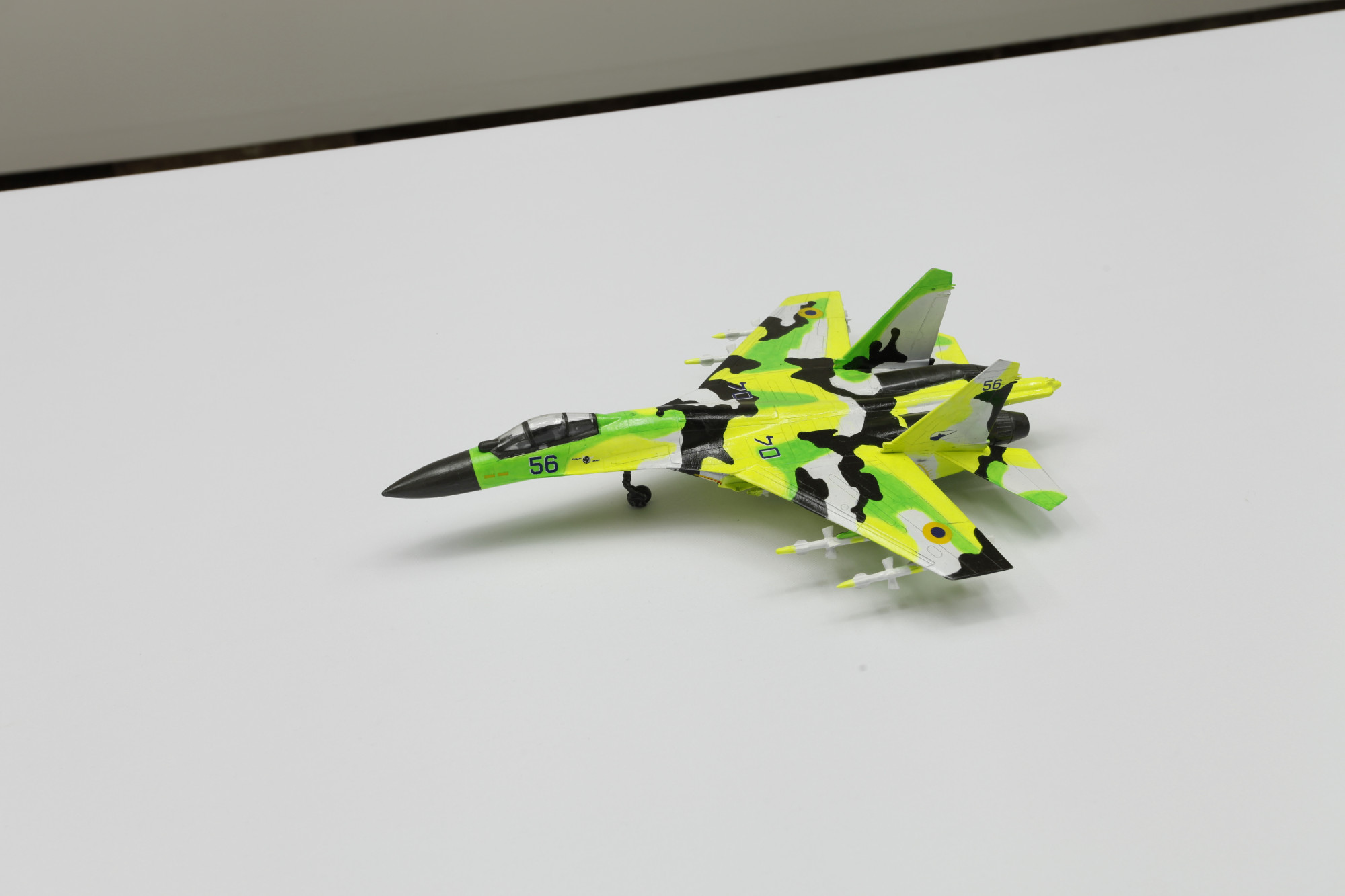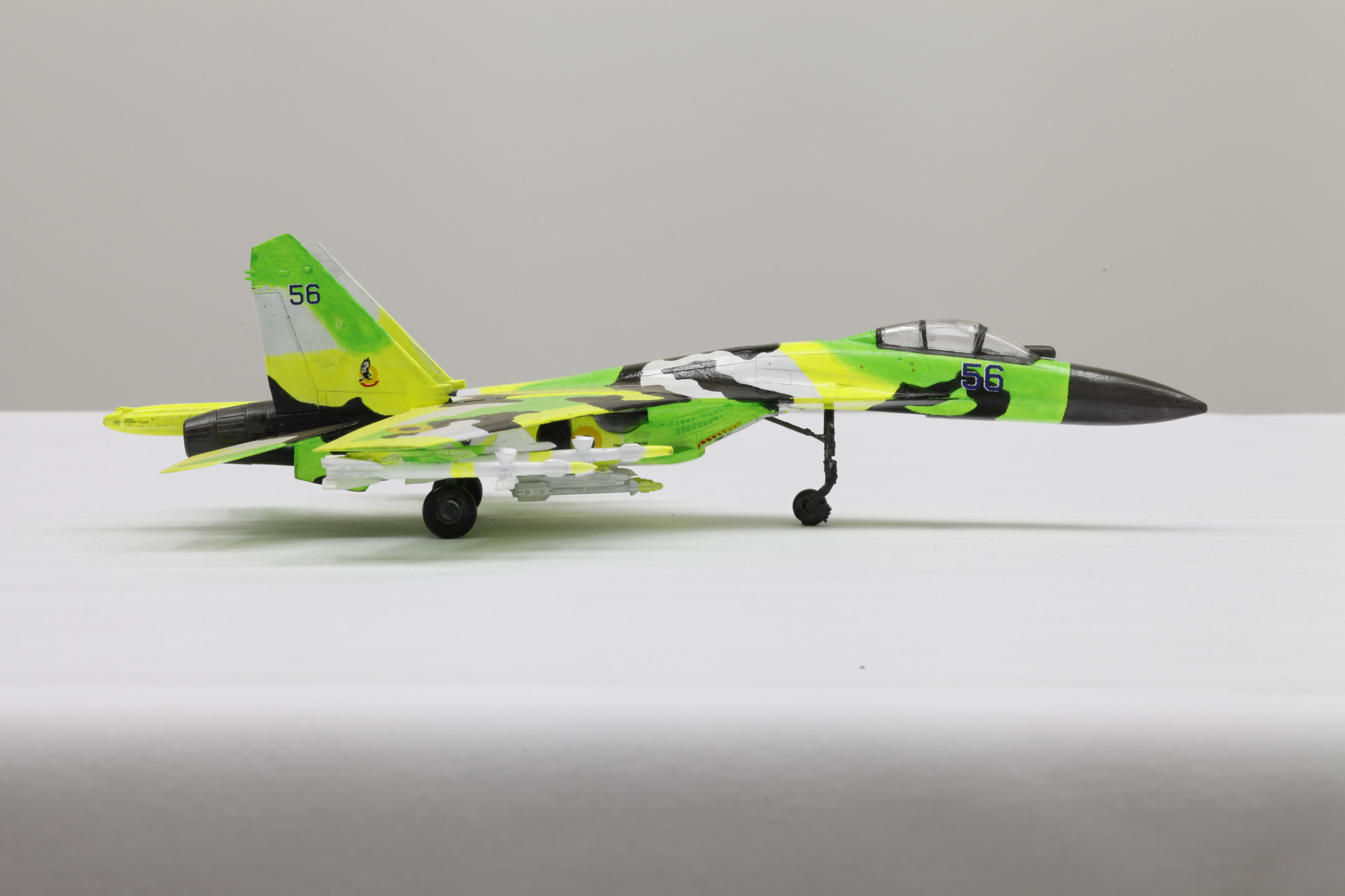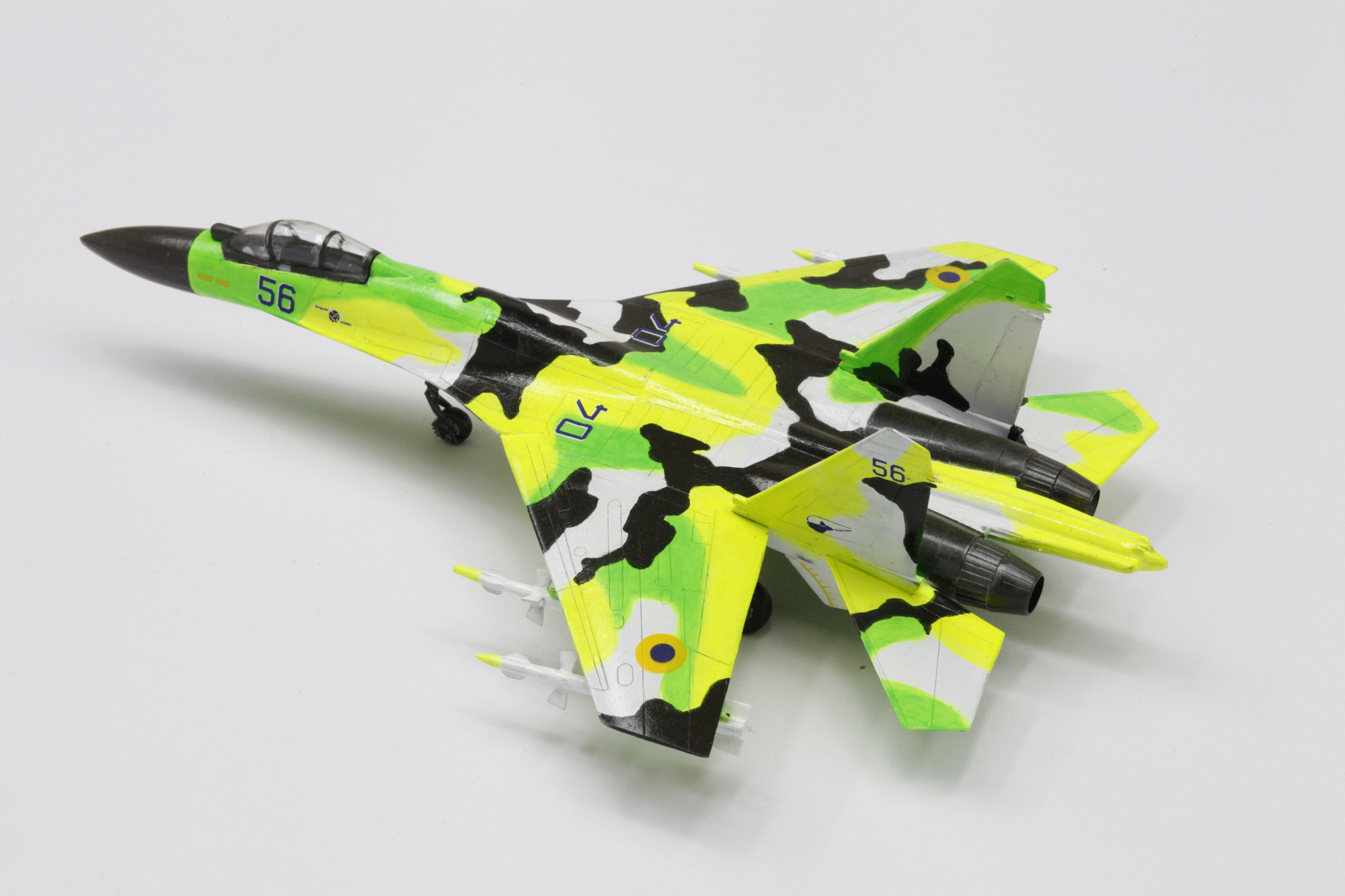Nicolas Ceccaldi, Camouflage Chameleon
Francis Plagne
Venture out to Rosanna in the next couple of weeks and you can see something rather rare in the COVID-Normal Melbourne art world: a solo exhibition by a young New York-based international artist. In the unlikely setting of a suburban backyard shed lovingly transformed into a white-walled (but still dirt-floored) gallery space, Guzzler presents a new sculptural installation by Nicolas Ceccaldi. A busy schedule over the last few years has seen his elusive work exhibited at a string of major institutions and commercial galleries across Europe and North America. The Guzzler exhibition consists of a small model fighter jet, painted by the artist in a camouflage pattern of black, white, fluorescent yellow and fluorescent green and displayed in the centre of the gallery on a crisply ironed white tablecloth hung over a rectangular table.
As Jerry Leiber and Mike Stoller asked, “Is that all there is?” Well, yes. How might we begin to approach such an austere, even parsimonious, presentation?

While a look at Ceccaldi’s previous work helps to place this exhibition within the broader context of his practice, it also highlights its singularity, for no other presentation of the artist’s work approaches this degree of simplicity. Though associated with the post-Kippenberger bad-boy stylings of artists like Mathieu Malouf, Ceccaldi’s work continues the exploration of calculated “badness” and ugliness in a more muted, inscrutable vein than many of his peers. Like the Guzzler exhibition, much of his previous work uses readymade mass-produced objects. Sometimes these have been exhibited unaltered, as in Wearables, his 2012 exhibition comprising fifteen store-bought pairs of fairy wings displayed on the floor of a Brooklyn gallery. In most instances, however, Ceccaldi’s objects are modified, adding collage elements or additional paint to assembly-line oil paintings bought at Sears for a 2016 exhibition in Mexico City, for instance. Ceccaldi also has a line in rather grimly unattractive paintings depicting lone figures and stock images of romantic couples on muddy expressionist surfaces built up into grotesquely thick impasto. But his work generally eschews flashy messiness for a deliberately underwhelming Gothic aesthetic. A series constructed from inverted crucifixes affixed to faux-Rococo plastic mirrors exhibited in Dijon in 2017 typify this aspect of the artist’s work, appearing to celebrate the enervation of the rebellious symbols familiar from the iconography of metal music.

This fascination with pop culture figures of darkness has perhaps reached its apex in the group of paintings and assemblages—enough to fill two solo exhibitions—Ceccaldi has created referring to the 2019 Batman spin-off film Joker. Ceccaldi’s Joker exhibitions are accompanied by extensive press releases that detail how each work relates to the film, sometimes specifying particular scenes. Similarly, the Guzzler exhibition is framed by a statement from the artist that explains that the model jet is a reproduction of the Su-27, a Soviet aircraft developed in the late 1970s as a response to the American F-15. The artist has assembled this kit model according to its instructions, including the tiny stickers that replicate Russian text and military insignia. The only alteration Ceccaldi has made is in the paint job, which loosely replicates the camouflage pattern of a Japanese F-15 but in a fluorescent colour palette. The artist points out the absurdity of this paint job as the brightness of the fluorescence cancels out the camouflaging function of the pattern. As with the texts accompanying the Joker exhibitions, the only thing the artist doesn’t tell us is why.
Everything in the Guzzler installation functions to focus our attention on this small, unimposing work. If the sculpture had been displayed on the floor, we could have assumed that part of its role was to activate the exhibition space in the sense achieved by the miniature post-minimalist sculptures of Joel Shapiro, for example, where, forced to delicately walk around small objects and crouch down to examine them, viewers become conscious of their bodies in space in a different way from the absorptive contemplation of traditional painting or sculpture. But displayed on its blankly white tablecloth, Su-27 Guzzler—even its title gives us nowhere else to look!—presents more like a museum artefact, inviting to examine it in detail. We circle it, looking at the small plastic parts, stickers and paint; we leave the gallery scratching our heads trying to understand the significance of this physically unimposing object that has nevertheless managed to occupy our attention.

There seems to be no particular cultural reference to model assembly and painting as a hobby intended here other than, perhaps, in a degree of wilful amateurism also evident in some other aspects of Ceccaldi’s work. Nor is the historical detail provided about this aircraft evidence of the artist’s special interest in the subject—more likely it was paraphrased from a Wikipedia article. We might compare Ceccaldi’s work here with one of the rare artists of the later twentieth century to have made extensive use of military iconography, Ian Hamilton Finlay. Although Finlay’s strange work with WW2 war machines is the product of a genuine obsession—one among many for the Scottish artist-poet, whose work is also studded with references to Presocratic philosophy and the French Revolutionary Saint-Just—and thus miles away from Ceccaldi’s casual reference, a comparison between the two is still helpful. If Finlay’s sculptures of war machines of the air and sea force the contradiction between the rational calm of their neo-classical style and the violence of their subjects, Ceccaldi’s work is entirely lacking in any sense of violence or threat. Rather, in its miniature stature and flimsy plastic appearance, Ceccaldi’s work is like an abandoned children’s toy. It strikes us as something comical, even pathetic—and it does so deliberately.

Ceccaldi’s work has been exhibited widely in high-profile contexts, but not a great deal has been written about it, and the few reviews contain their fair share of ambivalent judgments. Writing about Ceccaldi’s 2014 exhibition Red Wine at the Kunstverein München for Artforum, John Beeson wondered if Ceccaldi was exhibiting deliberately “disparate, unresolved” work in an attempt “to disappoint or alienate viewers”. Beeson also noted how the multiple references embedded in the work added up to semantic “white noise” without any specific, discernible meaning or content. These observations certainly hold for the Guzzler exhibition, which takes Ceccaldi’s cultivation of disappointment in a new, sardonically site-specific direction, dangling an enticing carrot—a solo exhibition by New York art star in out-of-the way-location—then proceeding to chuckle at the resulting puzzlement.

If this account makes Ceccaldi’s work sound like a cynical game (a charge that has been levelled against it in the past), it is not entirely fair. Tucked away among their explanatory details, the artist’s exhibition texts offer some surprisingly direct and seemingly earnest thoughts on aesthetics. (Though, when reading them, we can’t entirely shake the suspicion that this earnestness is itself a mask). Of the Joker works, he points to how “the recovery of expressive autonomy from the artwork is inversely proportional to the spectator’s prior familiarity with the film”. That is, the less we know about the referent to which these hyper-specific works point, the more likely it is we can encounter them as objects possessing aesthetic value. In his text for Camouflage Chameleon, Ceccaldi makes a direct statement of his ideas about Art with a capital A, with reference to the playful contradiction between the camouflage pattern and its fluorescent colour palette: “Once again, Art eludes the worldly chain of cause and effect and proves itself antithetical in nature to the pressures of functionality”. These two statements from the artist add up to an aesthetic credo identifying art with the refusal of instrumental usefulness and specific meaning.

Perhaps this helps us to make some sense of the insistently underwhelming material qualities of Ceccaldi’s work and the referential “white noise” that ultimately adds up to very little. It is a negative conception of art, as something not useful, not conventionally meaningful, not beautiful, perhaps not even very interesting but precisely for that reason able to be understood only as art. To frame it in terms of a quality, rather than an absence of qualities, we might borrow a term from Rosalind Krauss, who in her classic 1966 essay on the work of Donald Judd refers to his work as an “irritant”. She means that Judd’s work (contrary to his own understanding of it) causes through its perceptual ambiguity a heightened awareness of the gap separating our awareness of the object’s physical nature from our experience of how it appears to us. Ceccaldi’s work is an “irritant” in a very different way: it makes us itchy, nags at us with suggestions of meaning, depth and completeness that it will never fulfill. In managing to open up a black hole of interpretative speculation with such a physically and conceptually modest work, I have to admit that Su-27 Guzzler possesses a kind of elegance. But I can’t entirely dismiss Leiber and Stoller’s question: is that all there is?
Francis Plagne is a writer and musician from Melbourne.


